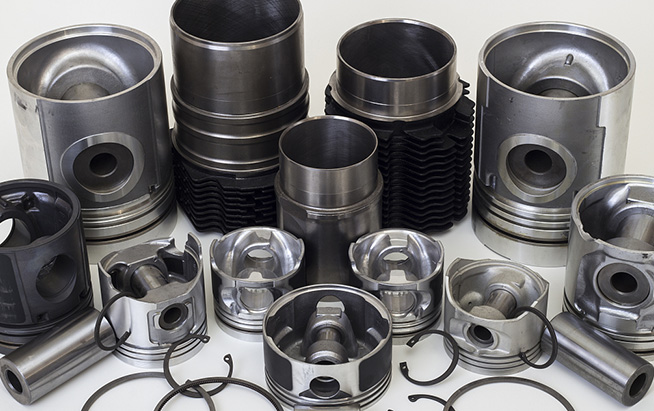How Do Motorcycle Piston Rings Work?
Piston rings play a vital role in the piston assembly, serving essential functions related to sealing and lubrication within motorcycle engines. The following provides a detailed overview of the working principles of pistons and their rings.
How the Piston Works
The piston is a cylindrical component, typically made from lightweight alloy, that plays a key role in a motorcycle engine by sealing the cylinder and transmitting motion. Its upper section is known as the piston head, while the lower part connects to the piston pin, which in turn links to the crankshaft via the connecting rod. As described earlier, the piston moves back and forth during the engine’s four-stroke cycle—intake, compression, power, and exhaust—transforming the energy from combustion into mechanical energy.
Working Principle of the Piston Ring
Piston rings are circular components typically made from materials like cast iron or steel that can withstand high temperatures and resist wear. Fitted around the outer surface of the piston, these rings perform several essential functions:
Cylinder Sealing: One of the main roles of piston rings is to prevent compressed air-fuel mixtures and combustion gases from leaking past the piston into the crankcase. During the compression and power strokes, the rings maintain close contact with the cylinder wall to form an airtight seal.
Lubrication Support: Piston rings help distribute and retain a thin layer of oil between the piston and cylinder wall. This lubrication minimizes friction and wear, protecting both surfaces and improving engine efficiency.
Heat Dissipation: Piston rings transfer heat from the piston to the cylinder wall, aiding in temperature control. This helps prevent overheating and ensures the piston operates within safe thermal limits.
Oil Control: In motorcycle engines, oil is sprayed near the piston to reduce friction. The piston rings prevent excessive oil from reaching the combustion chamber, which could disrupt the combustion process and increase emissions.
Together, the piston and its rings ensure smooth engine operation, efficient fuel combustion, and reduced mechanical wear—key factors in maintaining performance and extending the life of a motorcycle engine.
How to Install Motorcycle Piston Rings?
Replacing motorcycle piston ring is one of the more manageable maintenance tasks for riders. If you've already removed the pistons and discovered more significant damage—such as scoring or wear on the cylinder walls—you may need to have the engine re-bored. In that case, new pistons and rings will also be required. Regardless of whether you're replacing just the rings or both pistons and rings, the installation process remains the same in both situations.
Step 1 – Prepare the Pistons and Cylinders:
Begin by removing the engine cover and taking out the pistons. Carefully lift each piston up and to the side. Inspect both the pistons and cylinder walls for signs of wear, scoring, or other damage. If re-boring is necessary, send the cylinders to a machine shop for precise machining. Once the rebored cylinders are returned, thoroughly wash them with soap and water to remove any metal shavings or residue. Dry them completely, then apply a light coat of oil to protect the cylinder walls. Finally, wipe down the new oversized pistons to ensure they are clean and ready for installation.
Step 2 – Prepare the Rings:
Wipe each piston ring thoroughly to ensure it is clean and free of debris. Each ring has a small end gap that must match the engine manufacturer's specifications, which typically range between 0.08 and 0.25 millimeters, depending on the bore size. To measure this gap accurately, place the ring inside the cylinder and push it about half an inch from the top using the piston. This helps square the ring within the bore for a precise reading. If the gap is too small, carefully file the ends of the ring to bring it within spec. Take your time during this step—precision is critical for proper engine performance.
Step 3 – Install the Piston Rings:
Piston rings are hard yet brittle and can break if mishandled. You can install them using a ring expander or your fingers, but be cautious—over-expanding the ring may cause it to snap. Different engines require different ring configurations. For example, a four-stroke engine may use either one-piece or three-piece rings.
Install the rings one at a time, carefully sliding each into its respective groove near the top of the piston. Avoid twisting or overlapping the rings during installation. If you're using a three-piece ring set, make sure to stagger the ring gaps around the piston by about one-half to one-third of a full rotation. This helps maintain proper compression and prevents blow-by.
Step 4 – Replace the Pistons and Engine Top:
Before reassembly, ensure that the pistons, rings, and cylinder walls are thoroughly coated with a thin layer of oil to aid in initial startup and reduce friction. Reinsert the pistons into the cylinder and reinstall the engine cover, following the reverse order of disassembly.
Important Reminder:
Always use piston rings that match your engine’s specific size and model. Using oversized rings in an attempt to boost compression will only result in poor sealing, increased wear, and potential engine damage. Proper fitment is essential for optimal performance and longevity.



